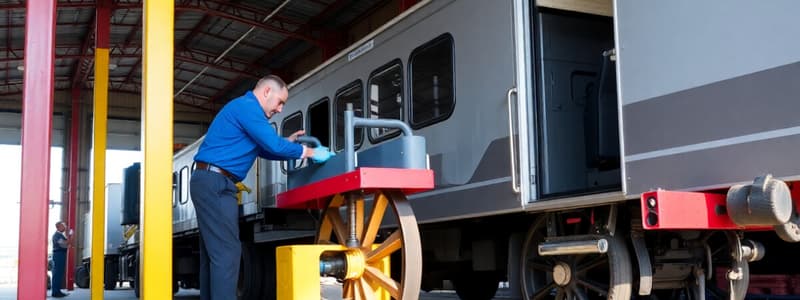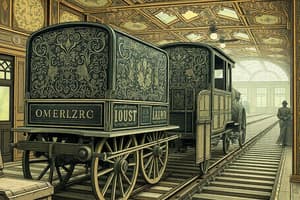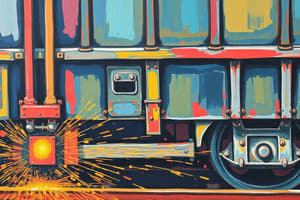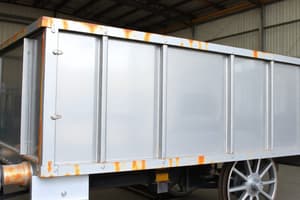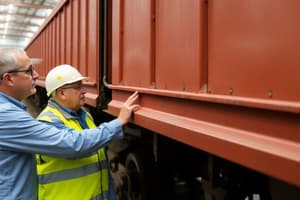Podcast
Questions and Answers
What is the warranty period for newly built wagons?
What is the warranty period for newly built wagons?
- 24 months (correct)
- 36 months
- 18 months
- 12 months
What must newly built wagons display for warranty identification?
What must newly built wagons display for warranty identification?
- Inspection results
- Warranty legend (correct)
- Vendor details
- Maintenance schedule
Who is responsible for inspecting newly built wagons during the warranty period?
Who is responsible for inspecting newly built wagons during the warranty period?
- Engineering staff
- Vendor's quality control
- Train Crew
- Representative of C&W (correct)
Which category of defects can result in charges against the wagon builder during the warranty period?
Which category of defects can result in charges against the wagon builder during the warranty period?
What should be done with newly built wagons that are due for warranty inspection?
What should be done with newly built wagons that are due for warranty inspection?
Which of the following is NOT a fault that can be rectified at the expense of the wagon builder?
Which of the following is NOT a fault that can be rectified at the expense of the wagon builder?
What information is NOT included in the warranty legend stenciled on the wagons?
What information is NOT included in the warranty legend stenciled on the wagons?
Which type of defect is not attributed to improper manufacturing or fitting?
Which type of defect is not attributed to improper manufacturing or fitting?
What is a feature of roller bearing defects per the inspection guidelines?
What is a feature of roller bearing defects per the inspection guidelines?
Which welding defect is specifically mentioned in the inspection manual?
Which welding defect is specifically mentioned in the inspection manual?
Which manufacturing or fitting defect involves the shape of rivet heads?
Which manufacturing or fitting defect involves the shape of rivet heads?
What type of failure is indicated by the breakage of the DV/brake cylinder?
What type of failure is indicated by the breakage of the DV/brake cylinder?
What constitutes improper protection in wagon maintenance?
What constitutes improper protection in wagon maintenance?
Which defect is directly related to improper assembling processes?
Which defect is directly related to improper assembling processes?
Which defect is associated with train pipe leakage?
Which defect is associated with train pipe leakage?
What type of defect would require the workshop in-charge to report to the roller bearing manufacturer?
What type of defect would require the workshop in-charge to report to the roller bearing manufacturer?
What is the codal life for a bogie tank wagon with air brake and CASNUB bogie?
What is the codal life for a bogie tank wagon with air brake and CASNUB bogie?
Which officer is NOT involved in the condemnation process of over-age wagons?
Which officer is NOT involved in the condemnation process of over-age wagons?
What condition must be met for the condemnation of under-age wagons?
What condition must be met for the condemnation of under-age wagons?
What is the process for handling condemned wagons once they are approved?
What is the process for handling condemned wagons once they are approved?
What must be included when reporting defects attributable to the manufacturer?
What must be included when reporting defects attributable to the manufacturer?
What is the maximum service life stipulated for open bogie wagons with air brake and CASNUB bogie?
What is the maximum service life stipulated for open bogie wagons with air brake and CASNUB bogie?
What is the primary focus during the warranty inspection of BTPN wagons?
What is the primary focus during the warranty inspection of BTPN wagons?
Which detail is NOT required to be reported for warranty inspections?
Which detail is NOT required to be reported for warranty inspections?
Where should materials be sent in case of a material failure?
Where should materials be sent in case of a material failure?
What kind of defects are supposed to be clearly indicated as attributable to the manufacturer?
What kind of defects are supposed to be clearly indicated as attributable to the manufacturer?
Which document contains guidance for examining cradles and anchoring rivets?
Which document contains guidance for examining cradles and anchoring rivets?
What is the significance of the Contract Number during reporting?
What is the significance of the Contract Number during reporting?
What should be recorded in the forwarding memo when sending materials for testing?
What should be recorded in the forwarding memo when sending materials for testing?
Which type of failure is NOT emphasized during the warranty inspections of BTPN wagons?
Which type of failure is NOT emphasized during the warranty inspections of BTPN wagons?
Which of the following is NOT a required part of warranty inspection?
Which of the following is NOT a required part of warranty inspection?
What must the train examining staff ensure before issuing a fit certificate?
What must the train examining staff ensure before issuing a fit certificate?
At what maximum speed can goods wagons be attached to a passenger train?
At what maximum speed can goods wagons be attached to a passenger train?
What must be recorded on the brake certificate prior to train departure?
What must be recorded on the brake certificate prior to train departure?
What must be specially checked for wagons that have been humped?
What must be specially checked for wagons that have been humped?
Which of the following is NOT a requirement for wagons attached to a passenger train?
Which of the following is NOT a requirement for wagons attached to a passenger train?
What is the intent of conducting an intensive examination of goods stock?
What is the intent of conducting an intensive examination of goods stock?
What is required for wagons to avoid being overdue for POH/ROH?
What is required for wagons to avoid being overdue for POH/ROH?
Who must countersign the brake certificate before a train departs?
Who must countersign the brake certificate before a train departs?
What is included in the pattern of train examination for terminating loads?
What is included in the pattern of train examination for terminating loads?
Before the dispatch of the train, what must be checked regarding the wagons?
Before the dispatch of the train, what must be checked regarding the wagons?
What is the axle load for the BOXNEL / BOYEL wagons?
What is the axle load for the BOXNEL / BOYEL wagons?
Which of the following wagon types has a service life of 6 years according to the first column?
Which of the following wagon types has a service life of 6 years according to the first column?
Identify the wagon type with the shortest service life listed in the first column.
Identify the wagon type with the shortest service life listed in the first column.
What is the indicated service life for BRSTN and BWTB wagons?
What is the indicated service life for BRSTN and BWTB wagons?
Which wagon type is associated with a service life of 4.5 years in the subsequent use column?
Which wagon type is associated with a service life of 4.5 years in the subsequent use column?
What is the primary reason for marking an empty wagon as sick for POH up to 30 days in advance?
What is the primary reason for marking an empty wagon as sick for POH up to 30 days in advance?
Identify which of the following wagon types displays a warranty life of 4.5 years.
Identify which of the following wagon types displays a warranty life of 4.5 years.
What is the required action for the Pedestal Crown Sides if the dimension is less than 147 mm?
What is the required action for the Pedestal Crown Sides if the dimension is less than 147 mm?
What thickness actions are required for components if the dimension exceeds 321 mm?
What thickness actions are required for components if the dimension exceeds 321 mm?
Which component requires its vertical side to be renewed by welding if the wear exceeds 4 mm?
Which component requires its vertical side to be renewed by welding if the wear exceeds 4 mm?
When should liners be provided for the Pedestal Jaw 22 WM?
When should liners be provided for the Pedestal Jaw 22 WM?
What is the action required if the slope surface wear of the wedge is measured at 3 mm?
What is the action required if the slope surface wear of the wedge is measured at 3 mm?
What information must the representative of C&W ensure is included on the warranty report?
What information must the representative of C&W ensure is included on the warranty report?
Which addresses should a warranty report for a wagon built by a private manufacturer be sent to?
Which addresses should a warranty report for a wagon built by a private manufacturer be sent to?
What is the role of the Senior Divisional Mechanical Engineer in the warranty inspection process?
What is the role of the Senior Divisional Mechanical Engineer in the warranty inspection process?
What happens if a wagon builder returns the warranty inspection report?
What happens if a wagon builder returns the warranty inspection report?
What types of files and registers must the Train Examining Depot maintain?
What types of files and registers must the Train Examining Depot maintain?
What must be included in the forwarding memo when sending materials for testing?
What must be included in the forwarding memo when sending materials for testing?
Who are the parties that receive warranty reports for wagons built by railway workshops?
Who are the parties that receive warranty reports for wagons built by railway workshops?
What is the responsibility of the representative of C&W regarding the warranty report submission date?
What is the responsibility of the representative of C&W regarding the warranty report submission date?
What is emphasized for the inspection of wagons built by railway workshops regarding report submission?
What is emphasized for the inspection of wagons built by railway workshops regarding report submission?
Which repair should be performed at the sick line when patching the side wall is needed?
Which repair should be performed at the sick line when patching the side wall is needed?
Which of the following areas requires attention under Intensive repairs?
Which of the following areas requires attention under Intensive repairs?
What type of repair is indicated for side doors according to the work areas table?
What type of repair is indicated for side doors according to the work areas table?
Which repair task is NOT included as a part of Sick line activities?
Which repair task is NOT included as a part of Sick line activities?
What should be checked and repaired on the side pillars during the maintenance work?
What should be checked and repaired on the side pillars during the maintenance work?
Which repair task applies to both ROH and POH work areas?
Which repair task applies to both ROH and POH work areas?
Which of these actions is necessary for ensuring the water-tightness of covered wagons?
Which of these actions is necessary for ensuring the water-tightness of covered wagons?
For which of the following tasks is primer paint explicitly required?
For which of the following tasks is primer paint explicitly required?
What is required for intensive repair work on the underframe of a wagon?
What is required for intensive repair work on the underframe of a wagon?
What is the primary consideration when checking side walls for corrosion?
What is the primary consideration when checking side walls for corrosion?
What must the train examining staff verify regarding the wagons before issuing a fit certificate?
What must the train examining staff verify regarding the wagons before issuing a fit certificate?
What is the primary requirement for goods wagons to be attached to a passenger train?
What is the primary requirement for goods wagons to be attached to a passenger train?
When recording the air pressure on the engine and brake van, who needs to countersign the brake certificate?
When recording the air pressure on the engine and brake van, who needs to countersign the brake certificate?
What condition makes wagons unacceptable for service if they appear on the inspection checklist?
What condition makes wagons unacceptable for service if they appear on the inspection checklist?
What is the main objective of performing an intensive examination of goods stock?
What is the main objective of performing an intensive examination of goods stock?
What aspect should be particularly checked for wagons that have been humped?
What aspect should be particularly checked for wagons that have been humped?
What is NOT a required condition for wagons to run attached to a passenger train?
What is NOT a required condition for wagons to run attached to a passenger train?
What certification is required by the station master prior to the train's departure?
What certification is required by the station master prior to the train's departure?
Which component's effectiveness must be recorded according to guidelines before the train departs?
Which component's effectiveness must be recorded according to guidelines before the train departs?
Flashcards
Warranty Period of New Wagons
Warranty Period of New Wagons
All newly built wagons have a warranty period of 24 months, or as specified in the purchase contract.
Warranty Defects
Warranty Defects
Defects due to inferior materials, poor workmanship, imperfect protection, or other contractor faults during the warranty period, are covered by the contract.
Wagon Inspection Procedure
Wagon Inspection Procedure
A systematic inspection of new wagons to identify defects within the warranty period, performed by C&W representatives to retrieve warranty charges.
Warranty Legend
Warranty Legend
Signup and view all the flashcards
Wagon Inspection Location
Wagon Inspection Location
Signup and view all the flashcards
Warranty Legend Details
Warranty Legend Details
Signup and view all the flashcards
POH and ROH Intervals
POH and ROH Intervals
Signup and view all the flashcards
Warranty Defect
Warranty Defect
Signup and view all the flashcards
Welding Defects
Welding Defects
Signup and view all the flashcards
Riveting/Bolting Defects
Riveting/Bolting Defects
Signup and view all the flashcards
Manufacturing/Fitting Defects
Manufacturing/Fitting Defects
Signup and view all the flashcards
Material Failure
Material Failure
Signup and view all the flashcards
Improper Protection
Improper Protection
Signup and view all the flashcards
Train Pipe Leakage
Train Pipe Leakage
Signup and view all the flashcards
Roller Bearing Defect
Roller Bearing Defect
Signup and view all the flashcards
Major Sick Lines
Major Sick Lines
Signup and view all the flashcards
Wagon Warranty Inspection
Wagon Warranty Inspection
Signup and view all the flashcards
Defect Reporting
Defect Reporting
Signup and view all the flashcards
Contract No.
Contract No.
Signup and view all the flashcards
Wagon Number
Wagon Number
Signup and view all the flashcards
Wagon Code
Wagon Code
Signup and view all the flashcards
Owning Railway
Owning Railway
Signup and view all the flashcards
Special Examination
Special Examination
Signup and view all the flashcards
Material Failure Report
Material Failure Report
Signup and view all the flashcards
Warranty Inspection Report
Warranty Inspection Report
Signup and view all the flashcards
Forwarding Memo
Forwarding Memo
Signup and view all the flashcards
Wagon Condemnation
Wagon Condemnation
Signup and view all the flashcards
Over-age Wagon Condemnation
Over-age Wagon Condemnation
Signup and view all the flashcards
Under-age Wagon Condemnation
Under-age Wagon Condemnation
Signup and view all the flashcards
Codal Life of Wagon
Codal Life of Wagon
Signup and view all the flashcards
Premature Condemnation
Premature Condemnation
Signup and view all the flashcards
Terminating Load Examination
Terminating Load Examination
Signup and view all the flashcards
Wagon Fit Condition
Wagon Fit Condition
Signup and view all the flashcards
Brake Power Percentage
Brake Power Percentage
Signup and view all the flashcards
Humped Wagon Check
Humped Wagon Check
Signup and view all the flashcards
Passenger Train Wagon Attachment
Passenger Train Wagon Attachment
Signup and view all the flashcards
Operative Brake Cylinders
Operative Brake Cylinders
Signup and view all the flashcards
Wagon Overload/Uneven Loading
Wagon Overload/Uneven Loading
Signup and view all the flashcards
Wheel Journal Cap Star Marks
Wheel Journal Cap Star Marks
Signup and view all the flashcards
POH/ROH Overdue Wagons
POH/ROH Overdue Wagons
Signup and view all the flashcards
Intensive Examination Purpose
Intensive Examination Purpose
Signup and view all the flashcards
BOXN wagon type
BOXN wagon type
Signup and view all the flashcards
POH due date
POH due date
Signup and view all the flashcards
Empty wagon sick leave
Empty wagon sick leave
Signup and view all the flashcards
BCN wagon type
BCN wagon type
Signup and view all the flashcards
BOST wagon type
BOST wagon type
Signup and view all the flashcards
Wagon maintenance schedule
Wagon maintenance schedule
Signup and view all the flashcards
Stainless steel wagons
Stainless steel wagons
Signup and view all the flashcards
Warranty Inspection Report
Warranty Inspection Report
Signup and view all the flashcards
Wagon Inspection Procedure
Wagon Inspection Procedure
Signup and view all the flashcards
Disposal of Proforma
Disposal of Proforma
Signup and view all the flashcards
Warranty Report Submission
Warranty Report Submission
Signup and view all the flashcards
C&W Representative
C&W Representative
Signup and view all the flashcards
Railway Board
Railway Board
Signup and view all the flashcards
Senior Divisional Mechanical Engineer
Senior Divisional Mechanical Engineer
Signup and view all the flashcards
Policy Instructions on Warranty Inspection
Policy Instructions on Warranty Inspection
Signup and view all the flashcards
Maintenance of Records
Maintenance of Records
Signup and view all the flashcards
Terminating Load Examination
Terminating Load Examination
Signup and view all the flashcards
Wagon Fit Condition
Wagon Fit Condition
Signup and view all the flashcards
Brake Power Percentage
Brake Power Percentage
Signup and view all the flashcards
Humped Wagon Check
Humped Wagon Check
Signup and view all the flashcards
Passenger Train Wagon Attachment
Passenger Train Wagon Attachment
Signup and view all the flashcards
Operative Brake Cylinders
Operative Brake Cylinders
Signup and view all the flashcards
Wagon Overload/Uneven Loading
Wagon Overload/Uneven Loading
Signup and view all the flashcards
Wheel Journal Cap Star Marks
Wheel Journal Cap Star Marks
Signup and view all the flashcards
POH/ROH Overdue Wagons
POH/ROH Overdue Wagons
Signup and view all the flashcards
Intensive Examination Purpose
Intensive Examination Purpose
Signup and view all the flashcards
Key Seat Wear Limit
Key Seat Wear Limit
Signup and view all the flashcards
Crown Roof Liner Requirement
Crown Roof Liner Requirement
Signup and view all the flashcards
Pedestal Jaw Liners
Pedestal Jaw Liners
Signup and view all the flashcards
Wedge Slope Wear Limit
Wedge Slope Wear Limit
Signup and view all the flashcards
Vertical Surface Wear Limit
Vertical Surface Wear Limit
Signup and view all the flashcards
Sickline Repairs
Sickline Repairs
Signup and view all the flashcards
Body Repair Work
Body Repair Work
Signup and view all the flashcards
ROH Repairs
ROH Repairs
Signup and view all the flashcards
POH Repairs
POH Repairs
Signup and view all the flashcards
Sole Bar Repairs
Sole Bar Repairs
Signup and view all the flashcards
Skirting Repairs
Skirting Repairs
Signup and view all the flashcards
Door Fastening Repairs
Door Fastening Repairs
Signup and view all the flashcards
Wagon Watertightness
Wagon Watertightness
Signup and view all the flashcards
Sickline
Sickline
Signup and view all the flashcards
Work Areas
Work Areas
Signup and view all the flashcards
Study Notes
Maintenance, Warranty, and Condemnation
- This chapter provides general information on the frequency of various inspections and maintenance schedules for goods stock on active routes.
- Prescribed periods for POH (Periodic Overhaul) are outlined for different types of stock. Detailed repair practices during POH are covered in separate chapters.
- A table at the end of the chapter summarizes the prescribed intervals for POH and ROH (Routine Overhaul) of wagons.
Warranty Inspection of Newly Built Wagons
- Warranty period for newly built wagons is 24 months, or as specified in the purchase contract.
- Manufacturing defects, including inferior materials, poor workmanship, inadequate protection, and other constructional faults, are covered under warranty.
- A systematic inspection process is outlined to identify warranty-related defects. Wagons must have a warranty legend attached. The legend displays the contract number, commissioning date, commissioning entity, and inspection due/completion dates and the inspecting entity.
- Wagons flagged for warranty inspection should be temporarily removed from the train and sent to a designated sick line for thorough inspection.
- Only defects attributable to the manufacturer (material, workmanship, protection, or other faults) are considered.
Reporting Method
- Detailed reporting requirements are outlined for warranty inspection reports, including specific information fields (contract number, wagon number, ownership, manufacturing date, inspection dates, and type of defect).
- All reports must include a serial number.
- For material failures, reports should be forwarded to the appropriate chemist/metallurgist for detailed test reports.
- Reports must be sent within 20 days of inspection to concerned authorities. A "Nil" report should be filed if no defects are found that are attributable to the manufacturer.
Estimated Cost of Rectification
- No cost estimates for rectification should be included in warranty inspection reports.
- Costs will be communicated by the appropriate party from the Railway Board.
- A written certificate must be included if the defect is due to material/workmanship/protection issues by a contractor.
Maintenance and Records
- A designated file should contain policies, instructions, and intermediate/final inspection documents. An index sheet should track all instructions.
- A separate file should hold all inspection reports.
- A register should maintain data of wagons inspected during the warranty period (date of inspection, wagon number, owner, wagon code, builder name, commissioning date, observed defects, warranty report number and date, and remarks).
Examination and Maintenance Periodicity
- Rolling-in examination must be performed on all terminating trains at stations where a train examining depot exists. Axles examination should be conducted after the train stops.
- A terminating train's load examination will occur as soon as the train stops
- Staff must verify that wagons are fit before train departure. (brake power, level of air pressure, etc)
- Ensure damaged wagons due to impacts during humping are reviewed.
ROH of Air Brake Wagon
- Routine Overhaul (ROH) should be performed at designated wagon depots.
- The procedures for the ROH depend on the type of wagon (e.g., bogie, tank).
- Detailed steps for disassembling, inspecting, and repairing various components are listed.
Wagon Condemnation
- Rolling stock can be condemned by authorized staff using relevant procedures.
- There are different types of wagons with different operational ages. A schedule outlining the codes, types and time in service are provided.
- A list of procedures and criteria is provided for under- or over-aged wagon condemnations. Specific instructions are noted, depending on the type of wagon (air brakes, bogies, tankers, etc.)
Work areas (where attention must be given)
- A table listing various work areas (e.g., body repairs, gear repairs) and corresponding inspection requirements.
- Specific types of work are specified, and their associated locations/frequencies (e.g., inspection of hinges, bolts, wheels, etc.).
Studying That Suits You
Use AI to generate personalized quizzes and flashcards to suit your learning preferences.
